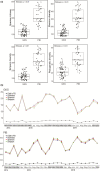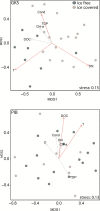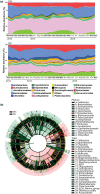The balance between deterministic and stochastic processes in structuring lake bacterioplankton community over time
- PMID: 32628343
- PMCID: PMC7540538
- DOI: 10.1111/mec.15538
The balance between deterministic and stochastic processes in structuring lake bacterioplankton community over time
Abstract
One major goal in microbial ecology is to establish the importance of deterministic and stochastic processes for community assembly. This is relevant to explain and predict how diversity changes at different temporal scales. However, understanding of the relative quantitative contribution of these processes and particularly of how they may change over time is limited. Here, we assessed the importance of deterministic and stochastic processes based on the analysis of the bacterial microbiome in one alpine oligotrophic and in one subalpine mesotrophic lake, which were sampled over two consecutive years at different time scales. We found that in both lakes, homogeneous selection (i.e., a deterministic process) was the main assembly process at the annual scale and explained 66.7% of the bacterial community turnover, despite differences in diversity and temporal variability patterns between ecosystems. However, in the alpine lake, homogenizing dispersal (i.e., a stochastic process) was the most important assembly process at the short-term (daily and weekly) sampling scale and explained 55% of the community turnover. Alpha diversity differed between lakes, and seasonal stability of the bacterial community was more evident in the oligotrophic lake than in the mesotrophic one. Our results demonstrate how important forces that govern temporal changes in bacterial communities act at different time scales. Overall, our study validates on a quantitative basis, the importance and dominance of deterministic processes in structuring bacterial communities in freshwater environments over long time scales.
Keywords: community assembly; 16S rRNA gene; bacterial community composition; mountain lakes; temporal dynamics.
© 2020 The Authors. Molecular Ecology published by John Wiley & Sons Ltd.
Figures





References
-
- Alfreider, A. , Pernthaler, J. , Amann, R. , Sattler, B. , Glockner, F. , Wille, A. , & Psenner, R. (1996). Community analysis of the bacterial assemblages in the winter cover and pelagic layers of a high mountain lake by in situ hybridization. Applied and Environmental Microbiology, 62(6), 2138–2144. 10.1128/AEM.62.6.2138-2144.1996 - DOI - PMC - PubMed
-
- Bertilsson, S. , Burgin, A. , Carey, C. C. , Fey, S. B. , Grossart, H.‐P. , Grubisic, L. M. , … Smyth, R. L. (2013). The under‐ice microbiome of seasonally frozen lakes. Limnology and Oceanography, 58(6), 1998–2012. 10.4319/lo.2013.58.6.1998 - DOI
Publication types
MeSH terms
Substances
LinkOut - more resources
Full Text Sources

